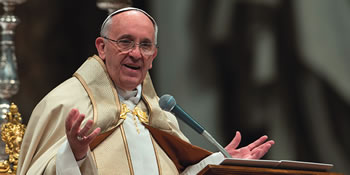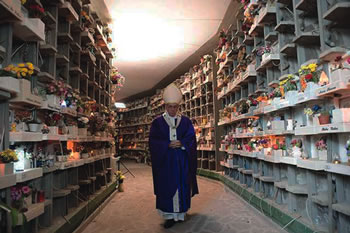All Saints and All Souls Days
 All Saints' Day
All Saints' Day
The Book of Revelation refers to an essential characteristic of saints, saying they are people who belong totally to God. They are presented as an immense multitude of “chosen ones,” dressed in white and marked with the “seal of God” (See Revelation 7:2-4, 9-14). Through this last detail, with allegorical language, it is emphasised that the saints belong to God fully and exclusively, and that they are his property. What does it mean to bear the seal of God in one’s very life and person? The Apostle John again tells us: it means that in Jesus Christ we have truly become children of God (See 1 John 3:1-3).
Saints 'next door'
A second characteristic of the saints is that they are examples to emulate. Let us note -- not only those who are canonised, but the saints ‘next door,’ so to speak, those who, by the grace of God, strive to practice the Gospel in their everyday lives. Among these saints, we also find ourselves; perhaps someone in our family or among friends and acquaintances. We must be grateful for them, and above all we must be grateful to God who has given them to us, putting them close to us as living and contagious examples of the way to live and die in fidelity to the Lord Jesus and his Gospel. How many good people have we met and do we know, about whom we say, “This person is a saint!” We say it, it comes to us spontaneously. These are the saints next door, those who are not canonised but who live with us.
Eternal acts of love
Imitating their gestures of love and mercy is a bit like perpetuating their presence in this world. These evangelical gestures are indeed the only ones that can withstand the destruction of death: an act of tenderness, generous aid, time spent listening, a visit, a kind word, a smile. In our eyes, these gestures might seem insignificant, but in the eyes of God they are eternal, because love and compassion are stronger than death.
May the Virgin Mary, Queen of All Saints, help us to trust more in the grace of God, and to walk with enthusiasm along the path of holiness. Let us offer our daily efforts to Our Mother, and let us also pray to her for our dear departed, in the intimate hope of finding each other one day, all together, in the glorious communion of heaven.

Pope Francis at Prima Porta Cemetery, All Souls’ Day, 2016
Source: Vatican website, 1 November 2015
All Souls' Day
Hope in sadness
Job was in darkness, in fact, at death’s door. And, at that moment of anguish, of grief and of suffering, Job proclaimed hope: I know that my Redeemer lives, and at last He will stand upon the earth … and I shall see God … and my eyes shall behold, and not another (Job 19:25.27).
The Commemoration of the deceased has this twofold sense. A sense of sadness: a cemetery is sad, it reminds us of our dear ones who have gone. It reminds us also of the future, death, but in this sadness, we carry flowers, as a sign of hope, I can even say of celebration. And the sadness is mixed with hope. And this is what all of us feel today in this celebration: the memory of our dear ones, before their mortal remains; and hope.
All of us will tread this path sooner or later, with more or less grief, but with the flower of hope, with that strong thread that is anchored in the beyond. See, the hope of resurrection does not deceive.
"I will raise you up ..."
And the one who first trod this path was Jesus. We go on the path that he did. And the one who opened the door for us is He Himself, is Jesus. With His cross, He opened for us the door of hope, He opened the door for us to enter where we will contemplate God. I know that my Redeemer lives, and at last He will stand upon the earth … and I shall see God … and my eyes shall behold and not another.
We return home today with the memory of the past, of our dear ones that have gone, and the memory of the future, of the path we shall tread – with the certainty, the security; that certainty that issued from the lips of Jesus, I will raise you up on the last day (John 6:40).
Source: Zenit, 3 November 2016
 Entries(RSS)
Entries(RSS)